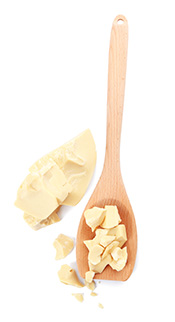
While it is not widely available, it is possible to buy isolated cocoa butter for use in cooking/recipes.
It gives pretty much anything you make a deliciously creamy taste, but is it good for us?
This article takes a look at the nutrition profile, potential health benefits, and a few tasty recipes.
What Is Cocoa Butter?
Otherwise known as theobroma oil, cocoa butter is the edible fat that is present in cocoa beans and most chocolate products.
Despite the “butter” in the name, cocoa butter has nothing to do with the dairy ingredient. Cocoa butter is a single ingredient food product extracted directly from the cocoa bean.
We can find cocoa butter in numerous chocolate bars, truffles, recipes, and also personal skincare products.
Typically, cocoa butter is quite expensive and so it is usually in higher quality products.
For example, budget-priced chocolates from Hershey and Cadbury usually use vegetable fat as a cheaper alternative.
Nutrition Facts
The tables below examine cocoa butter’s nutritional values per 100 grams (1);
Calories and Macronutrients
| Macronutrient / Calories | Amount (Grams / % RDA) |
| Calories | 884 kcal |
| Carbohydrate | 0 g |
| Fiber | – |
| Sugar | – |
| Fat | 100 g |
| Saturated Fat | 59.7 g |
| Monounsaturated Fat | 32.9 g |
| Polyunsaturated Fat | 3.0 g |
| Omega-3 | 100 mg |
| Omega-6 | 2800 mg |
| Protein | 0 g |
As shown above, cocoa butter provides a combination of mainly saturated and monounsaturated fats.
Micronutrients
| Vitamin / Mineral | Amount (% DV) |
| Vitamin K | 31% DV |
| Vitamin E | 9% DV |
Isolated fats are never going to be nutrient-dense, and this is the case for cocoa butter too.
The only vitamins that it contains are vitamins E and K.
Other Compounds
Unlike other cocoa products, cocoa butter contains virtually no stimulants like caffeine and theobromine.
Although there are small trace amounts present, the concentration is less than 0.1% of the amount in cocoa powder (2).
Is the Fat in Cocoa Butter Healthy?
The table below shows the four major fatty acids in cocoa butter and in what concentrations they are present (1);
| Fatty Acid | Type | Amount (%) |
|---|---|---|
| Stearic Acid | Saturated | 33.2% |
| Oleic Acid | Monounsaturated | 32.6% |
| Palmitic Acid | Saturated | 25.4% |
| Linoleic Acid | Polyunsaturated | 2.8% |
Between them, these four fatty acids make up more than 97% of the total composition.
Only trace amounts of other fatty acids make up the remaining 3%.
Stearic Acid
- Stearic acid is found in cocoa butter and shea butter (3).
- Compared to other saturated fats, a systematic review shows that stearic acid lowers LDL cholesterol and has a neutral effect on HDL (4).
- Another clinical study confirms this finding, with stearic acid lowering the ratio of LDL to HDL cholesterol (5).
Oleic Acid
- Oleic acid is the most widely distributed fatty acid in nature, and it is the predominant fat in olive oil (6).
- Studies suggest that oleic acid has a protective effect against cardiovascular disease and insulin resistance (7).
- Oleic acid appears to be important for immune health and may have anti-inflammatory activity (8).
Palmitic Acid
- Palmitic acid is a common saturated fatty acid and it occurs in both animal foods and plant foods (9).
- The current evidence is inconclusive on whether palmitic acid has positive or negative effects on health (10).
- Palmitic acid may cause problems alongside an excessive intake of dietary carbohydrates (11).
- Palmitic acid was viewed in a negative way for a long time due to the fear over saturated fats. However, more research is necessary to determine its relative effect on health and potential confounding factors.
Linoleic Acid
- Linoleic acid is a major fat from the omega-6 family of essential fatty acids.
- This fatty acid is present in most foods in varying proportions, but it is highly concentrated in nuts, seeds and “vegetable” (seed) oils.
- Linoleic acid plays an important pro-inflammatory role in our body and it is responsible for proper wound healing (12).
- Although this fatty acid is essential to our health, excessive amounts can have a negative effect. This is because the overproduction of inflammatory compounds can contribute to chronic disease risk (13).
Cocoa Butter Contains a Healthy Range of Fatty Acids
As the fatty acid profile of cocoa butter shows, there is a nice balanced range of fatty acids.
On the positive side, the two predominant fatty acids (stearic acid and oleic acid) have a lot of positive health research behind them.
Therefore, consuming cocoa butter in sensible amounts can be supportive of good health.
How Is Cocoa Butter Made?
The production process of cocoa butter is relatively simple but time-consuming.
Here is a summary of the production process;
1. Picking the cocoa fruit
For those who were not aware, cocoa is a fruit.
Cocoa farmers pick the fruit and remove the cocoa beans (seeds) from inside.
2. Farmers prepare the cocoa beans for processing
During this stage of the process, the farmers clean the beans and then roast them to increase the depth of flavor.
After roasting, the beans are removed from their shells and broken down into smaller pieces (cocoa nibs).
3. The cocoa nibs are melted into cocoa liquor
In the next stage of the process, the cocoa nibs are melted down into a liquid known as ‘cocoa liquor’.
4. Cocoa liquor enters a hydraulic press to separate it into cocoa butter and cocoa solids/powder
Next, the cocoa liquor is transferred to a hydraulic press.
A hydraulic press is a piece of machinery that exerts tremendous pressure to press food and separate the fat from the solids.
Once the machine starts pressing the cocoa liquor, the cocoa butter separates from the cocoa mass and runs out to a storage compartment.
This cocoa butter is then collected and solidifies as it cools.
After this final stage, the cocoa butter is ready for packing, sale and distribution.
Health Benefits of Cocoa Butter
As mentioned earlier, cocoa butter isn’t the most nutritious food in the world.
That said, it does have a few benefits and these are listed below;
1. A Source of Healthy Fats
Fat intake is vital to our overall health and plays a role in hormonal and energy processes in the body (14).
As seen in cocoa butter’s fatty acid profile, the predominant fats are also associated with a better cholesterol profile (higher HDL to LDL) and reduced inflammatory markers.
Although cocoa butter is very high in energy/calories, the fat profile it contains is quite healthy.
2. Cocoa Butter is Very Heat Stable
Some fats (such as polyunsaturated vegetable oils) are a terrible choice for high-heat cooking because they break down into toxic compounds at high heat (15).
Fortunately, the fatty acids in cocoa butter have good oxidative stability at high heat.
The monounsaturated fat oleic acid has shown on numerous occasions that it stands up to being heated well.
Additionally, the other prevalent fatty acids in cocoa butter are the saturated fats stearic and palmitic acid.
Saturated fats are among the very best choices for cooking due to their relative stability at heat (16).
For these reasons, cocoa butter can be used safely in a range of recipes.
3. Cocoa Butter Contains Polyphenols
You may have heard that polyphenols have an “antioxidant” effect, but this is not entirely accurate.
These compounds are, however, believed to help with cell signaling systems and play a role in mediating inflammation. In truth, more research is necessary because we do not accurately understand how polyphenols exert their apparent health benefits (17).
Besides their potential benefits for us, polyphenols also help to protect cooking fats from oxidization when exposed to oxygen/heat.
This fact is one reason why cooking fats such as extra virgin olive oil are so healthy compared to ultra-processed vegetable oils.
Similar to regular cocoa, cocoa butter also contains polyphenols, particularly flavonoids.
These compounds may add to the oxidative stability and – possibly – health benefits of cocoa butter (18).
4. Benefits For Personal Skin Care
In addition to the nutritional benefits of cocoa butter, a large number of skincare products make use of it.
The reason why is because cocoa butter has hydration properties that make it ideal for use as a moisturizer. In fact, many cultures have used cocoa butter for this reason for centuries (19).
Although cocoa butter is relatively expensive, it is much cheaper than most famous cosmetic brands.
For this reason, some people enjoy using pure cocoa butter as a moisturizer.
Cocoa Butter Recipes
If you are looking for ways to use cocoa butter, then here are some interesting recipes ideas.
1. Homemade Creamy Vanilla Dark Chocolate Bar
It is sometimes hard to find good quality chocolate with so many “milk chocolate” products full of sugar.
However, if we make our own at home, we can make a sugar-free version that is a lot easier than you might imagine.
This bar is an excellent option for those looking to keep their blood-glucose down or just for anyone who wants to reduce their sugar intake.
For this homemade chocolate bar, you need the following;
Ingredients
- 1 cup (100 g) cocoa powder
- 1 cup (220 g) cocoa butter
- 1 cup (200 g) erythritol
- 1 tsp pure vanilla extract
- 1/2 tsp salt
Instructions
2. Cocoa Mocha Coffee
If you want a tasty mocha then you can make a great one with cocoa butter as a substitute for milk.
On the plus side, it takes no time at all. Here’s what you need;
Ingredients
- 1 large brewed cup of coffee
- 2 tbsp cocoa butter
- 1 tbsp heavy cream
- 1/2 tsp cocoa powder
- Sweetener (optional)
- Pinch of salt
Instructions
Note
This coffee tastes seriously good, and if you are a fan of bulletproof coffee, then this alternative is much better.
However… it is full of isolated fat, and it isn’t particularly nutritious, so think of it as a treat rather than an everyday thing!
3. White Chocolate Mousse
For a thick and creamy sweet treat, here is a sugar-free white chocolate mousse recipe.
Ingredients
- 1 cup (240 ml) heavy cream
- 4 tbsp erythritol
- 2 oz (56 g) cocoa butter
- 1/2 tsp vanilla extract
- 2 oz (56 g) macadamia nuts
- 1 oz (28 g) dark chocolate shavings
Instructions
Where To Buy Cocoa Butter?
Cocoa butter isn’t the most common ingredient you will find in stores, but it may be possible to pick it up in a local health store or market.
You can also find a wide range of options online.
Final Thoughts
Cocoa butter is a pure and natural fat that comes from cocoa beans.
In addition to its amazing taste, it is also rich in a variety of healthy fats – mainly oleic and stearic acid.
That said, it is worth remembering that cocoa butter is very calorie-dense and doesn’t contain many nutrients.
In other words; there are many foods out there that are more nutritious.
However, providing it is in moderation, cocoa butter can play a delicious part of a healthy diet.
Related Articles
11 Types of Chocolate and Cocoa Products
Dark Chocolate: Does It Have Benefits?
Theobromine: Benefits and Side Effects of Cocoa’s Interesting Phytochemical

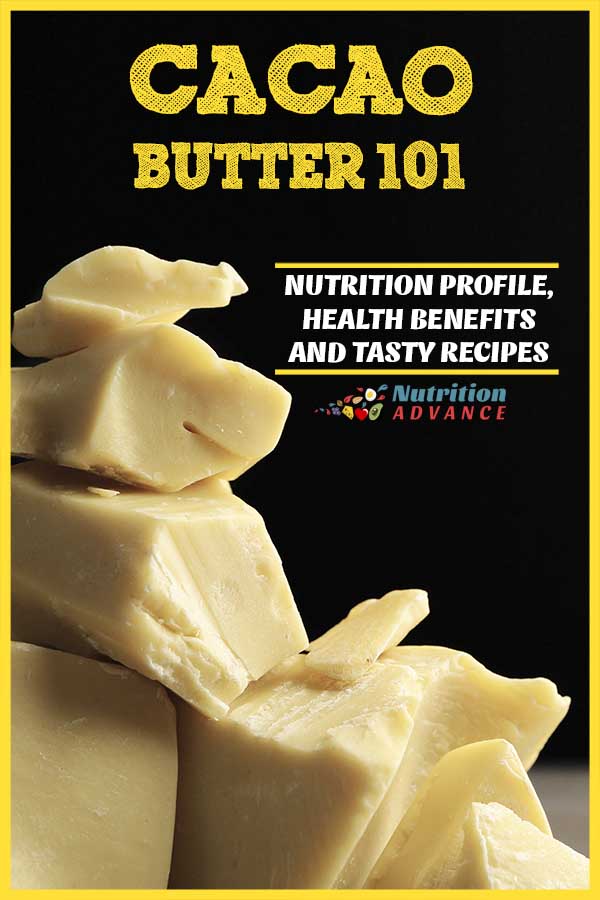
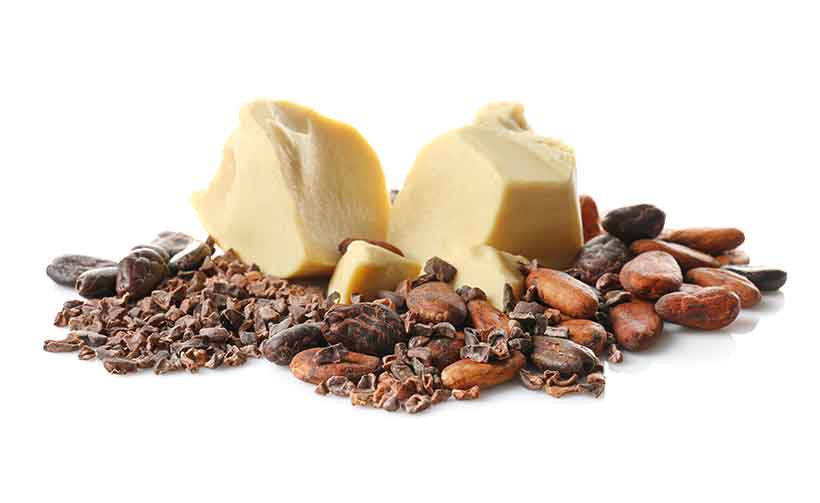
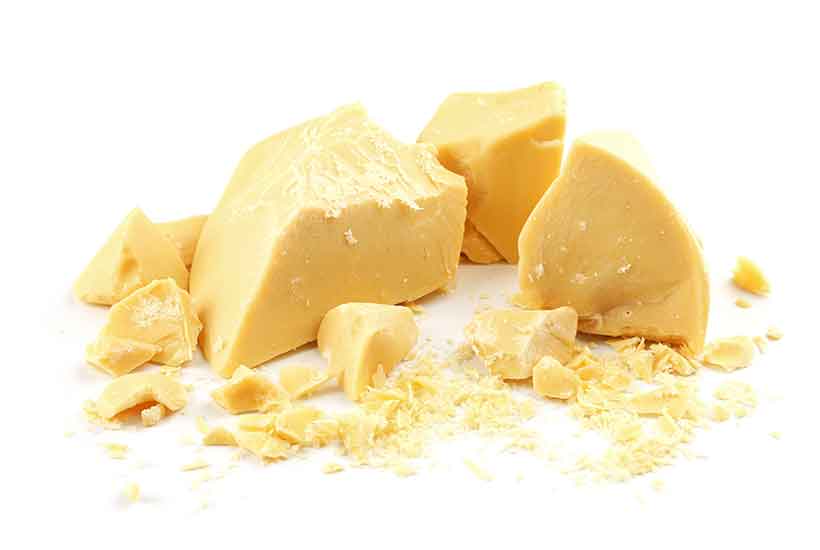
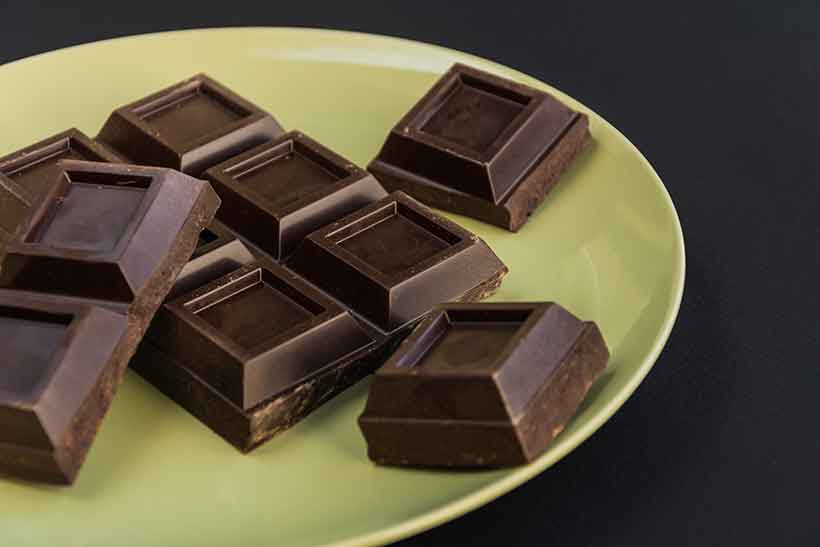
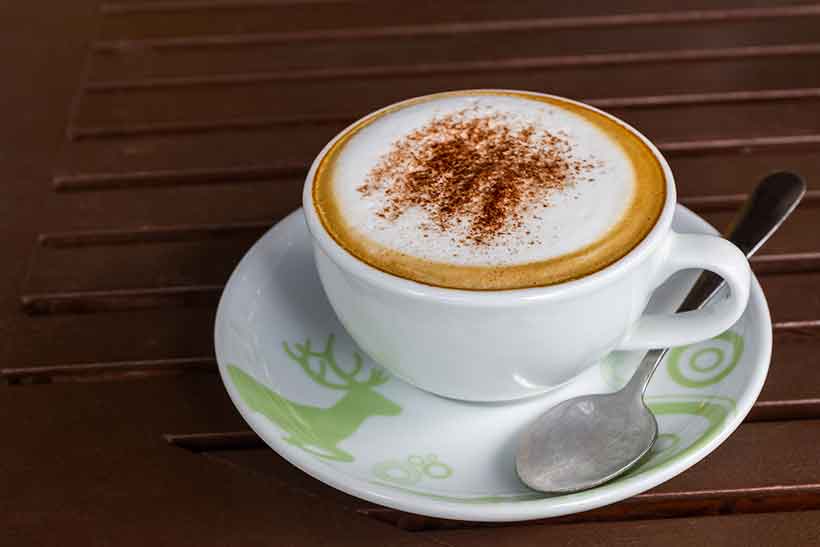
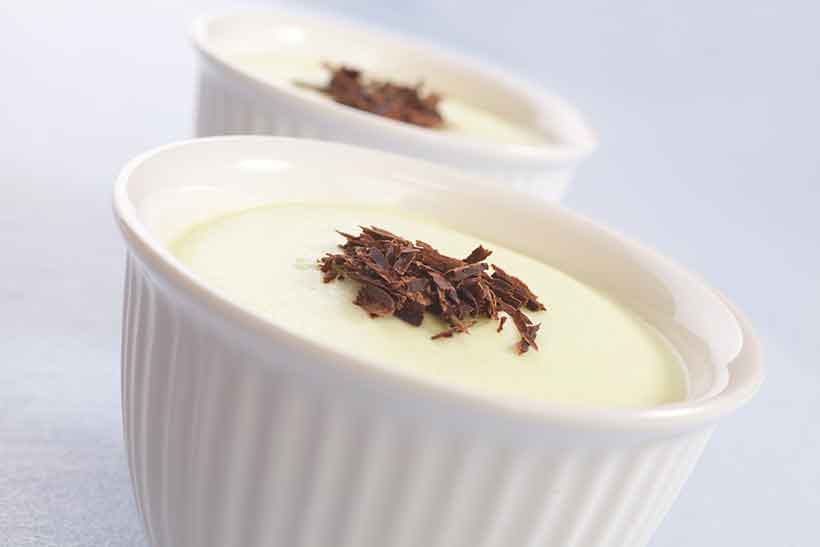
So for the chocolate bar can I use Cacao Butter? I have a bag of it but unsure if it matters.
Sure – that will work fine!
do you have to eat this right away because it will melt quickly? Another words, right out of the freezer?
The melting point is around 34°C (100°F) so unless you’re in a really hot place, it should be okay!
this was good! I found myself eating many squares. That won’t hurt me, right? lol
That probably depends on just how many of them you are eating!
I mean, I don’t know much about erythritol, so taking lets say 5 squares, won’t kick me out of ketosis? How many calories per one square?
Oh, okay! Erythritol is non-glycemic so that wouldn’t be a worry. As for calories, it would depend on how many squares you made (providing you used the listed ingredients)?
Can I use honey in place of erythritol if so how much
Hi Bev,
You can if you want. Erythritol is used as a 1:1 replacement for regular sugar, so you can find your preferred conversion rate from that maybe?
As I understand, the recommendation is typically to replace a whole cup of sugar with between 1/2 and 2/3 cup of honey.